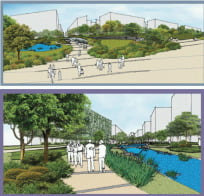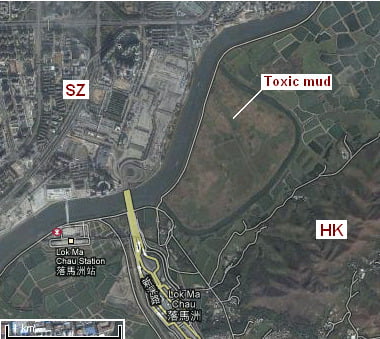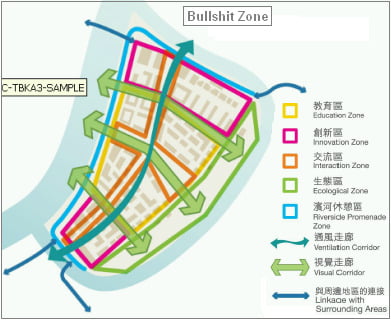Two columns on the same topic show interesting differences between Hong Kong’s local English-language newspapers, though neither is able to answer the underlying question: what is it with the Lok Ma Chau Loop? The mysterious pile of toxic mud transferred from Shenzhen to Hong Kong jurisdiction after a 1990s river-straightening exercise is in the news again.
For years now, murky interests have been badgering the Big Lychee’s government to allow the area to be developed as (allegedly) an industrial park, an exhibition area, a creative blah-blah, and all manner of hubs and zones. Now our planning authorities have unveiled a blueprint to turn the area into some sort of university district.
In the South China Morning Post, Jake van der Kamp obliquely voices various suspicions. Could it be that (presumably former) senior officials in Shenzhen procured personal interests in the land way back when it was still on their side of the border? (And if so, we could add, are they among those last heard of jailed and so on for corruption?) Could it be they have offered the well-connected New Territories Heung Yee Kuk mafia a slice of the action if it is developed? These are not new suspicions, yet the Hong Kong government seems incapable of coming up with answers.
Over in the Standard, the anonymous editorialist Mary Ma pushes the mystery beneficiaries’ case by presenting development of the Loop as a long-overdue boost to all: “an interactive platform for Hong Kong and Shenzhen to create synergy.” She mocks the Hong Kong administration for dragging its feet on the Loop for years and guesses that she is joined by Mainlanders – at least those not in jail for bribery – in lamenting our tortuous public consultation and other procedures.
Where does the Hong Kong government stand in all this? Apparently somewhere very awkward. After complaints to Beijing from Pearl River Delta officials about their snotty and superior attitudes in the late 90s, our officials resolved to enjoy constructive cooperative relations with their counterparts over the border. This means never contradicting them, regardless of how unrealistic, self-serving or plain grasping they get. At the same time, the semi-feudal Heung Yee Kuk is represented in both the Legislative and Executive Councils, has friends in Beijing and includes members with the usual extensive business connections. (Hence Mary Ma’s stance: the Standard’s tycoon owner uses his newspapers to shoe-shine his peers and superiors exhaustively.)
So it could well be that our officials are humouring the mystery interests of Lok Ma Chau Loop as best they can. Chief Executive Donald Tsang declared developing the Loop one of his 10 Wonders of the Infrastructure Project World in his 2007 policy address. A cross-border task force was set up. A public engagement exercise produced more dreamy blather on hubs than you thought could ever exist. Meanwhile, the toxic mud silently bides its time. Is it an easily overcome problem, or is it, as some people mutter, a challenge/eco-disaster/impossible? The first planning summary provides what, to my untutored eyes, looks like a dutiful job by engineers who believe they’ll never have to execute the project. “The implications of contaminated mud on development costs and time will also be investigated,” is all they say on the matter.
The new outline plan summary foresees a “sustainable knowledge and technology exchange zone” made up of five zones, including ‘innovation’ and ‘interaction’ and one for a “pleasant and attractive waterfront environment surrounding the Loop.” Here’s a map that brings the vision vibrantly to life…
(Note that streets are henceforth to be known as the ‘Interaction zone’.)
 And if that doesn’t look half-hearted enough, there are the dreadful-looking artists’ impressions. Even when the bureaucrats are deadly serious, these tend to look unconvincing. But even allowing for that, these particular ones strike me as having an added air of indifference and insincerity about them. The fakeness of the human figures, the carelessly situated trees, the slapdash greenery and the throwaway buildings – it’s all somehow exaggerated. It’s as if the draftsmen concerned wanted to express their frustration; rather than portraying a scene of pastoral splendor to fool the public about what will really be a pile of ugly wasteful infrastructure, they are having to concoct a paradise on earth on paper to misrepresent a nasty development that won’t ever happen. Their spite and anger at this are evident in every brushstroke.
And if that doesn’t look half-hearted enough, there are the dreadful-looking artists’ impressions. Even when the bureaucrats are deadly serious, these tend to look unconvincing. But even allowing for that, these particular ones strike me as having an added air of indifference and insincerity about them. The fakeness of the human figures, the carelessly situated trees, the slapdash greenery and the throwaway buildings – it’s all somehow exaggerated. It’s as if the draftsmen concerned wanted to express their frustration; rather than portraying a scene of pastoral splendor to fool the public about what will really be a pile of ugly wasteful infrastructure, they are having to concoct a paradise on earth on paper to misrepresent a nasty development that won’t ever happen. Their spite and anger at this are evident in every brushstroke.
Or then… Maybe they really are going to try to develop the place.
It’s not clear – but then it’s mud isn’t it?




Speaking of seagulls: why don’t we ever see seagulls hopping around the seashore of Victoria harbor ? They are supposed to be flying rats, feeding off waste and such. Every big port city has seagulls.
All we have are fat pigeons.
Gotta love HK. A mystery development of some toxic mudflats, bound to benefit someone financially no doubt. A ‘mistake’ is made where a tycoon’s company benefits to the tune of some $1.5bn because the relevant Government Dept didn’t bother to check the size of the piece of land they weere selling. A school in the NT is pilloried. Their crime? making 30 cents profit on exercise books they sold.
I am in favour of Loop development, on the basis that it’s already a dump and will hopefully give the Government less time to devote to wrecking other areas of HK that don’t actually need redevelopment.
I suspect it will be hard to make the Loop uglier than it already is, but I’m sure the Government-Developer cabal is up to the challenge.
Wouldn’t the Loop be a perfect place for a landfill ? After all, the Government keeps telling us that our landfills are approaching their limits.
1. It’s far away, on the edge of Hong Kong, neatly located behind a mountain, so we neither see nor smell it.
2. It’s already polluted, so that is not an issue.
3. No need to remove the toxic mud.
4. Once it is filled up, in 2030 or so, it can be converted to a wetland/ bird sanctuary, or they can build country-side dachas for retired senior civil servants.
Forget the education/interaction hub. This could be the Room 101 for all right-minded people. Like me. So we could move into the Loop all the skin-whitening product shops, all the tacky tourist “sights” (such as the wretchedly contrived flag raising ceremony), most political parties, the Heung Yee Kuk, property developers, the Tsang Administration, EPD, PlanD, etc. We’d never hear from them again as they slowly sink into the toxic mud. Hong Kong, being freed from the above, would immediately become a more pleasant place to live. Air quality would improve, flats would double in size whilst halving in price, the fertility rate would increase, beer would be free, etc. You name it. Can’t believe no-one thought of this before …
Can we include Bonnie Gokson ? Can we ?
Stop all this far fetched wishful thinking – its going to be a hub.
More importantly has anyone else noticed that Donald has now joined the black hair dye brigade?